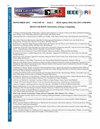通过考虑网站的替代位置优化公共交通网络
IF 1.3
4区 工程技术
Q3 COMPUTER SCIENCE, INFORMATION SYSTEMS
引用次数: 0
摘要
如今,大都市地区的规划都会考虑提高居民的生活质量,而城市交通则是主要关注点之一。研究指出,对公共交通和其他交通方式的投资旨在全面提高流动性。事实上,网络优化是一个 NP-困难问题,通常有许多相互冲突的目标需要同时优化。本文建议使用多目标进化算法来解决公共交通网络优化问题,重点是大都市公交线路。该建议包括优化公交站点的位置,进而获得经过这些站点的新线路,以最大限度地减少平均旅行时间、起点/终点之间的时间以及站点之间的距离差异。为了评估我们的建议,我们使用模拟器模拟了城市地区不同乘客的行为,并将优化后的线路与圣保罗市现有的公交线路进行了比较。根据我们的结果,优化后的公交线路比现有线路的平均旅行时间减少了 22%,在起点/终点之间花费的时间最多减少了 18%。本文章由计算机程序翻译,如有差异,请以英文原文为准。
Optimization of Public Transport Networks by Considering Alternative Positions for Network Stations
Netheradays planning of metropolitan areas considers to improve quality of life of their inhabitants and urbanmobility is one of the main concerns. Studies point out that investments in public transportation and other modes are aimedat the overall improvement of mobility. However, there is a gap in proper tools for optimizing public transport networks.In fact, network optimization is an NP-Hard problem and there are usually many conflicting objectives that need to beoptimized simultaneously. This paper proposes the use of manyobjective evolutionary algorithms to address the problem ofpublic transport networks optimization, focusing on metropolitan bus lines. The proposal consists in optimizing the position of bus stops and consequently obtaining new routes that pass through these stops in order to minimize the average travel time, the time spent between origin / destination and the variance of distance between the stops. To evaluate our proposal, a simulator was used to simulate the behavior of different passenger profiles in an urban area and the results were compared between the lines obtained by the optimization process and existing bus lines in the city of Sao Paulo. According to our results, optimized bus routes have mean travel time 22% less than the existing route and the time spent between origin/destination has decreased up to 18%.
求助全文
通过发布文献求助,成功后即可免费获取论文全文。
去求助
来源期刊

IEEE Latin America Transactions
COMPUTER SCIENCE, INFORMATION SYSTEMS-ENGINEERING, ELECTRICAL & ELECTRONIC
CiteScore
3.50
自引率
7.70%
发文量
192
审稿时长
3-8 weeks
期刊介绍:
IEEE Latin America Transactions (IEEE LATAM) is an interdisciplinary journal focused on the dissemination of original and quality research papers / review articles in Spanish and Portuguese of emerging topics in three main areas: Computing, Electric Energy and Electronics. Some of the sub-areas of the journal are, but not limited to: Automatic control, communications, instrumentation, artificial intelligence, power and industrial electronics, fault diagnosis and detection, transportation electrification, internet of things, electrical machines, circuits and systems, biomedicine and biomedical / haptic applications, secure communications, robotics, sensors and actuators, computer networks, smart grids, among others.
 求助内容:
求助内容: 应助结果提醒方式:
应助结果提醒方式:


